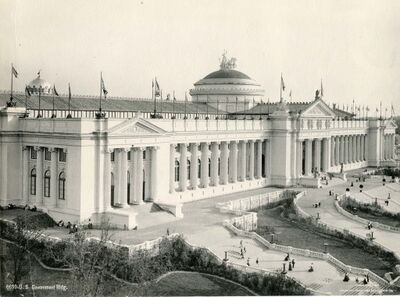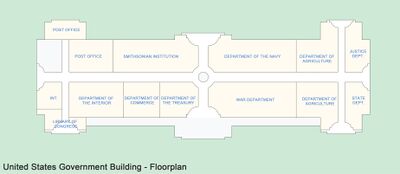US Government: Difference between revisions
No edit summary |
No edit summary |
||
| (One intermediate revision by the same user not shown) | |||
| Line 1: | Line 1: | ||
{{ | {{SHORTDESC:United States Government Building}} | ||
{{Infobox FairBuilding | {{Infobox FairBuilding | ||
| name = United States Government Building | | name = United States Government Building | ||
| Line 81: | Line 81: | ||
One of the most impressive outdoor exhibits were mounted big guns for coast defense, and where an army camp was maintained, showing the actual service conditions of the soldiers. Sea-coast defense drills took place daily at the big guns stationed on Government Hill. | One of the most impressive outdoor exhibits were mounted big guns for coast defense, and where an army camp was maintained, showing the actual service conditions of the soldiers. Sea-coast defense drills took place daily at the big guns stationed on Government Hill. | ||
==Department of Agriculture== | ===Department of Agriculture=== | ||
On each side of the central aisle, just beyond the War and Navy exhibits was the largest exhibit in the US building. A special exhibit was to show what the department was doing to assist the farmers of the United States and to develop their agricultural resources. | On each side of the central aisle, just beyond the War and Navy exhibits was the largest exhibit in the US building. A special exhibit was to show what the department was doing to assist the farmers of the United States and to develop their agricultural resources. | ||
Latest revision as of 06:30, 4 December 2022
 | |
| Location | Plateau of States |
|---|---|
| Construction | |
| Construction Cost | $350,000 ($10.6 million in 2021) |
| Architecture | |
| Architect | James Knox Taylor |
| Dimensions | 250' x 764' |
 | |
The United States Government Building was located on the Plateau of States and was a stately edifice, situated on the high ground overlooking the Main Picture on the east.
Description[edit | edit source]
Designed by James Knox Taylor, Supervising Director of the Treasury, the building was a general quadrangular, its main façade was marked by a central pavilion with two transverse pavilions, that formed end facades. A colonnade of Ionic columns, each 5 feet in diameter and 45 feet high, connected the pavilions. Its dome, the style of the Parthenon, surmounted by a quadriga, was a eye-catching feature of the structure. The roof was supported with steel trusses 70 feet high and 35 feet apart.
A grand stairway adorned with statues, formal beds of herbaceous flowers, clipped hedges and bay trees, showcased the visitors approach. The hill slope in front of the Government building was terraced with broad stairways, almost completely covering the slope.
As fitting with a host country, the US building was the largest structure ever provided at an Exposition by a Federal Government.
There were many departments showcased in the United States Government pavilion.
The Post Office Department[edit | edit source]
The Post Office showcased a railroad post office car. The mail handled consisted of letters and papers mailed to persons connected with the World's Fair, visitors receiving mail on the grounds, and also the out-going mail. Also included was a display of old-time relics from the post office museum at Washington that included an old-fashioned stage coach (complete with bullet holes), that once carried United States mails through a portion of the Louisiana Purchase territory.
Among the collection of documents showed the primitive postal methods in the early days of the Republic is seen from an old book of accounts kept by the first postmaster-general, Benjamin Franklin, all written by hand. Included in many of the hundreds of exhibits and items was a rare collection of stamps.
Department of Commerce and Labor[edit | edit source]
This exhibit pertaining to the census, a display of lighthouse lens and the Bureau of Standards showcased its standards for temperature, weights and measurements.
Library of Congress[edit | edit source]
Located at the northwest corner of the building and featured a large model of the original Library of Congress in Washington. Many rare manuscripts and book could be viewed.
The Interior Department[edit | edit source]
The Interior Dept. was found on the right hand side of the central aisle. The exhibit featured many aspects on the patenting of inventions. On view was he first type writer and sewing machine ever made. The model of Abraham Lincoln's celebrated device for lifting steamboats off shoals was shown. Also, the first harvesting machine, and first steam engine, (both created in the year 150 B. C.), were on display, the later made in Egypt.
Also included were hundreds of large photographs (and a moving picture exhibit), of Yellowstone Park, which illustrated its wonders and beauty.
Smithsonian Institute[edit | edit source]
The nations museum display was a large part of the Department of the Interior. It showcased actual skeletons of a large variety of dinosaurs. Some of the papier-mache coverings of these models of animals were made from the macerated bank notes that have been redeemed by the Government, among the models and the mounted animals were specimens of large game and birds from all parts of the world. There was also a great collection of beautiful butterflies and moths from all sections of the globe, as well as a complete collection of the earth's minerals.
Included was a large exhibit of meteorites, some of which weighed many tons and some massive pieces of petrified wood.
There was a large aboriginal Indians display of native pipes, musical instruments, water craft, ceremonial objects, ceramics, sculptures, fabrics, etc.
Treasury Department[edit | edit source]
Across the central aisle from the Interior Dept. were some of the old bonds shown dated back to 1804, and was apart of the transfer of the Louisiana territory. There were displays on how money was created and at 11 am. and 3 pm., daily, Exposition medals are coined here.
The Bureau of Public Health and the Marine Hospital Service had exhibits in the Treasury section. There was a model showing how a well becomes contaminated with typhoid fever or cholera germs by a neighboring cesspool. Drawings or models of improved tenement houses to replace the unsanitary dwellings of thousands of people in the large cities presented an object lesson in civic improvement.
Included was a large replica of the Statue of Liberty.
[edit | edit source]
The Navy displayed an exact-sized model of the battleship Missouri, full-size in width, one-quarter in length, complete with guns and appliances. Visitors were free to inspect the model. Every hour there were exhibitions of biograph motion scenes, illustrative of the life and duties of the crews on United States war vessels.
War Department[edit | edit source]
The War Department was across the center aisle from the navy exhibit and showcased fighting machinery of every variety seen, from the famous old Arsenal, Springfield, Mass. One displayed rifle was carried by Jefferson Davis when he was captured.
On display was a cartridge-making machine in operation, and a working signal corps telegraph station.
Other interesting features included a West Point Exhibit of old flags, guns, etc., and the office wagon used by Gen. George. H. Thomas during the Civil War.
There were models in levee construction, showing how the great levees protected thousands of miles of land along the Mississippi river.
One of the most impressive outdoor exhibits were mounted big guns for coast defense, and where an army camp was maintained, showing the actual service conditions of the soldiers. Sea-coast defense drills took place daily at the big guns stationed on Government Hill.
Department of Agriculture[edit | edit source]
On each side of the central aisle, just beyond the War and Navy exhibits was the largest exhibit in the US building. A special exhibit was to show what the department was doing to assist the farmers of the United States and to develop their agricultural resources.
The division of Entomology displayed still and live specimens of thousands of insects, destructive and beneficial, native to the US and foreign countries; and the plants upon which they prey.
The office of Experiment Stations had an exhibit covering the work of the agricultural colleges and experiment stations in the United States, Hawaii, Alaska and Puerto Rico. A display of every kind of tobacco grown in this and other countries was provided by the Soils Division.
Colored and uncolored transparencies showed the forest conditions in different parts of the US.
The Bureau of Animal Industry showed the inspection of meats, in a practical way, by girl operators.
Department of Justice[edit | edit source]
The Department of Justice was situated in the southeast corner of the building. There, one could peruse collections of rare old law books. There were autographs of Presidents Jackson, Lincoln, Grant, McKinley and others, as well as portraits of the Chief Justices, from: John Jay to Melville B. Fuller. Specimens of work done by inmates of penitentiaries were exhibited.
Department of State[edit | edit source]
This exhibit was on each side of the central aisle at the extreme west end of the building. There was a huge collection of rare documents and historical relics. One of the documents was the treaty with France, transferring the Louisiana territory, which event was commemorated by this World's Fair. The sword worn by George Washington in all the battles in which he participated during the Revolutionary War was showcased, including several other swords presented to him. In a glass case filled with other relics of Washington and Lafayette was a pair of old-fashioned eye-glasses, presented to the American general by the French marquis.
A 14 by 24 foot miniature of the capitol at Washington that cost $10,000 (equivalent to $301,593 in 2021) dollars was a popular exhibit.
Bureau of American Republic[edit | edit source]
This exhibit occupied the southwest corner of the building. It showed a large relief model of the Panama Canal and surrounding territory. Other features included: a relief map of the proposed Inter-Continental Railway, connecting the U.S. with the republics of Central and South America; samples of South American products; views of prominent buildings and historic maps, books and documents relating to these countries.
